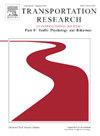Exploration of the Social-Psychological factors associated with Drivers’ engagement in protective cybersecurity behaviors: A TPB-based perspective
IF 3.5
2区 工程技术
Q1 PSYCHOLOGY, APPLIED
Transportation Research Part F-Traffic Psychology and Behaviour
Pub Date : 2025-05-28
DOI:10.1016/j.trf.2025.05.025
引用次数: 0
Abstract
With the advancements in hardware and software technologies, connected vehicles (e.g., vehicles with connections to the internet) become increasingly prevalent and their owners face growing cybersecurity threats. Therefore, it is important to investigate the social and behavioral factors that are associated with drivers’ engagement in cybersecurity-related behaviors to develop effective solutions. To this end, this paper explores the socio-psychological factors (e.g., attitude, norms, and perceived behavioral control) influencing drivers’ engagement in several cybersecurity-related behaviors through an exploratory survey study, grounded in the Theory of Planned Behavior. Based on responses from 405 connected vehicle owners, a partial least squares structural equation model was constructed to examine the structural relationships between key predictors and self-reported engagement in cybersecurity-related behaviors. Results indicate that perceived behavioral control emerged as the strongest predictor, while attitude, descriptive norms, and injunctive norms also played significant roles, their influence varied across demographic groups. Interestingly, objective cybersecurity knowledge showed substantial inter-individual differences but was not directly linked to engagement. Findings from the current study offer valuable insights into behavioral mechanisms underlying cybersecurity practices in the context of connected vehicles, informing strategies to enhance protective measures for drivers against emerging cyber threats.
驾驶员参与保护性网络安全行为的社会心理因素探讨:基于tbp的视角
随着硬件和软件技术的进步,联网车辆(例如连接到互联网的车辆)变得越来越普遍,其车主面临越来越多的网络安全威胁。因此,研究与驾驶员参与网络安全相关行为相关的社会和行为因素,以制定有效的解决方案非常重要。为此,本文以计划行为理论为基础,通过探索性调查研究,探讨影响驾驶员参与几种网络安全相关行为的社会心理因素(如态度、规范和感知行为控制)。基于405名网联车主的反馈,构建了偏最小二乘结构方程模型,以检验关键预测因素与自述网络安全相关行为参与之间的结构关系。结果表明,感知行为控制是最重要的预测因子,而态度、描述性规范和禁令规范也起着重要作用,它们的影响在人口统计学群体中有所不同。有趣的是,客观的网络安全知识显示出实质性的个体间差异,但与参与度没有直接联系。目前的研究结果为互联汽车背景下网络安全实践的行为机制提供了有价值的见解,为加强驾驶员对新出现的网络威胁的保护措施提供了信息。
本文章由计算机程序翻译,如有差异,请以英文原文为准。
求助全文
约1分钟内获得全文
求助全文
来源期刊
CiteScore
7.60
自引率
14.60%
发文量
239
审稿时长
71 days
期刊介绍:
Transportation Research Part F: Traffic Psychology and Behaviour focuses on the behavioural and psychological aspects of traffic and transport. The aim of the journal is to enhance theory development, improve the quality of empirical studies and to stimulate the application of research findings in practice. TRF provides a focus and a means of communication for the considerable amount of research activities that are now being carried out in this field. The journal provides a forum for transportation researchers, psychologists, ergonomists, engineers and policy-makers with an interest in traffic and transport psychology.

 求助内容:
求助内容: 应助结果提醒方式:
应助结果提醒方式:


